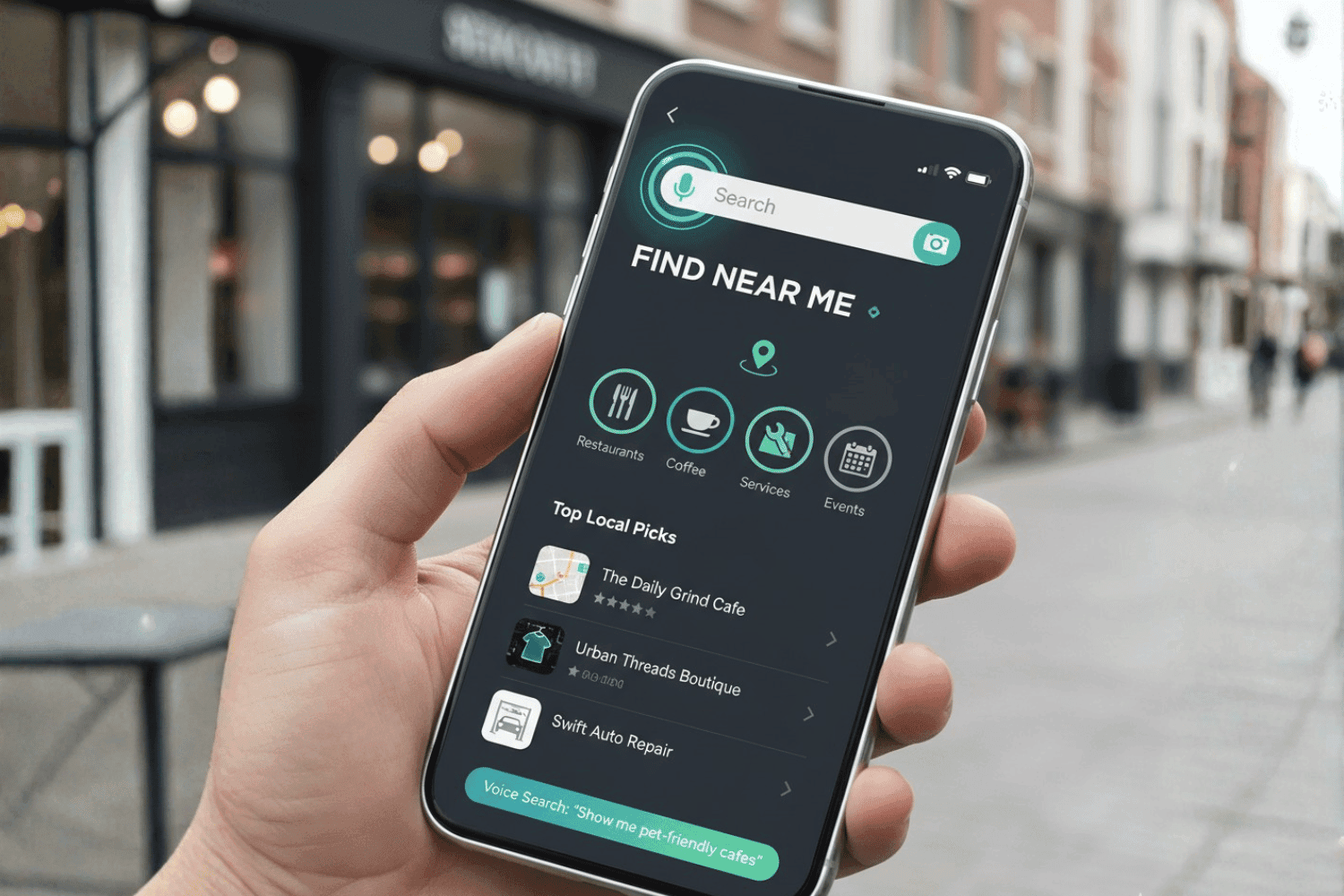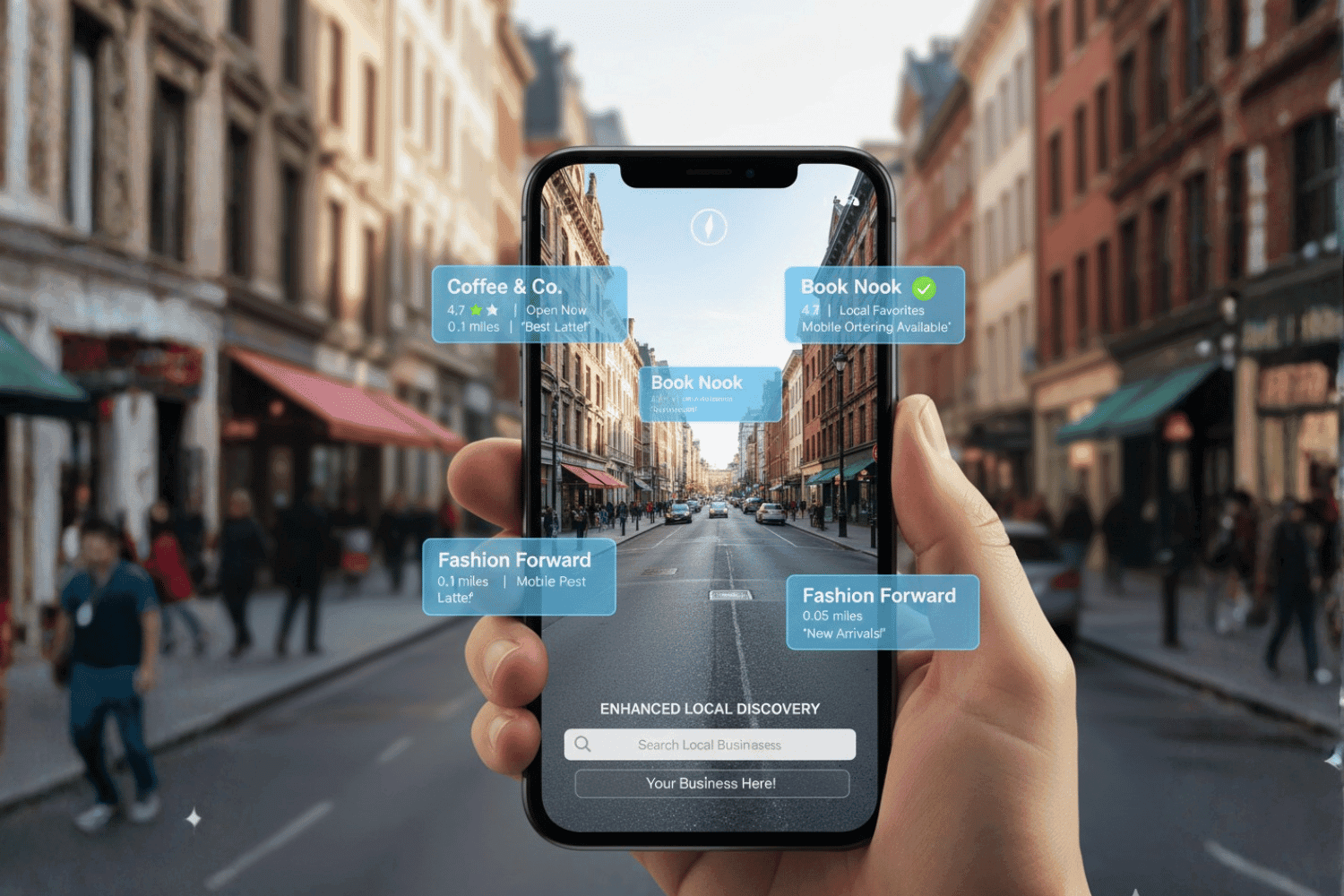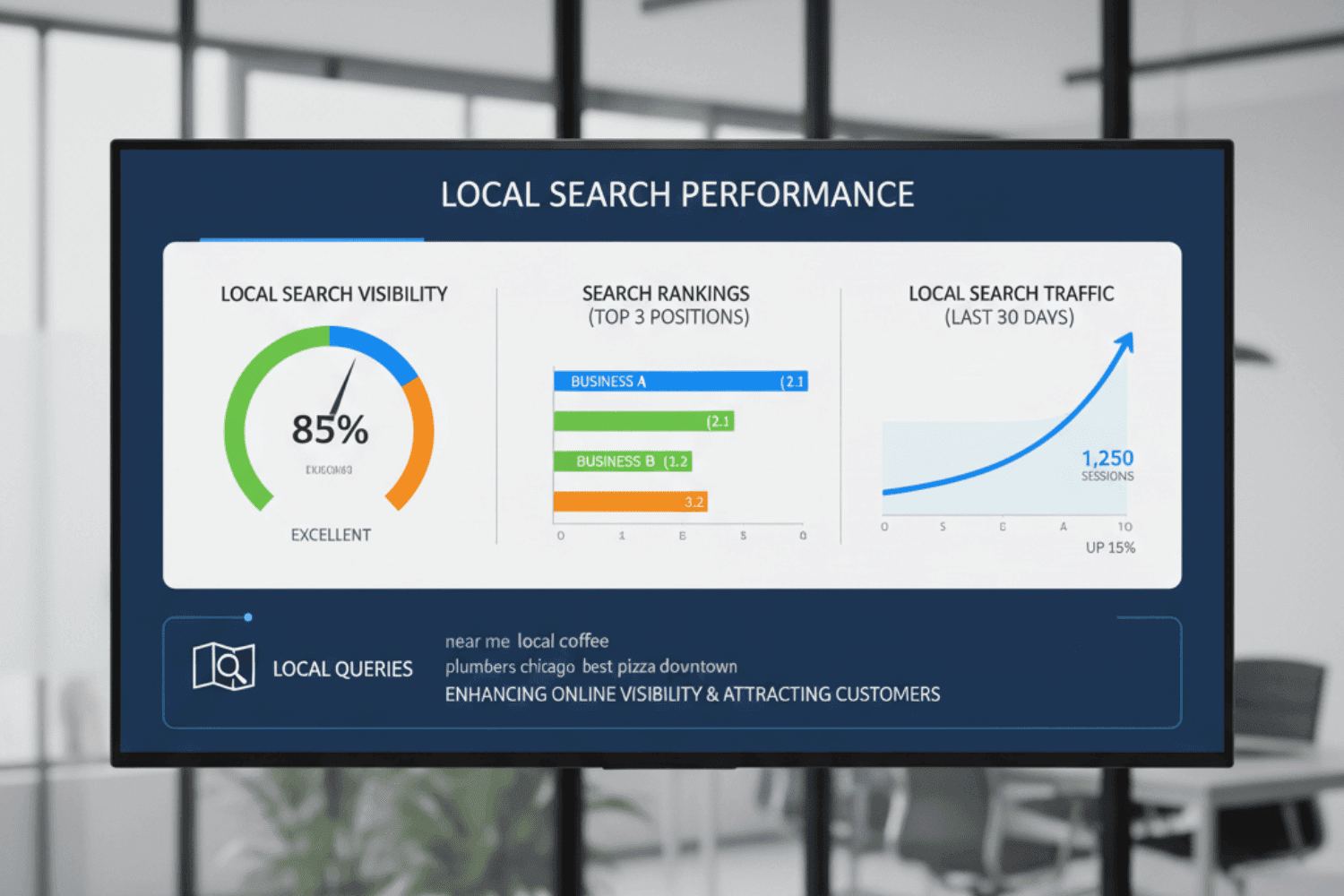The Future of Local Search: 2026 Trends You Should Be Preparing For
The way customers find local businesses is about to change forever. By 2026, the phrase “near me” will sound as outdated as asking for the Yellow Pages. What’s coming isn’t just an evolution of current local search—it’s a complete transformation that will reshape how local customers discover, evaluate, and engage with businesses in their area.
Unlike traditional advertising that interrupts potential customers, the future of local search will anticipate needs before they’re even expressed. Search engines powered by artificial intelligence and machine learning will understand context, predict intent, and deliver personalized search experiences that feel almost telepathic in their accuracy.
Key Takeaways
- Voice search will dominate 65% of local queries by 2026, requiring natural language optimization and conversational content strategies
- AI-powered hyper-personalization will create unique search experiences for each user based on behavioral patterns, location data, and real-time context
- Zero-click searches will account for 70% of local queries, making Google Business Profile optimization and structured data markup critical for visibility
- Augmented reality integration will transform how customers discover and interact with local businesses through visual search experiences
- Predictive local intent will anticipate customer needs before they search, requiring businesses to optimize for micro-moments and real-time data updates


Most businesses are still optimizing for yesterday’s local search landscape, focusing on basic local seo strategies while revolutionary changes accelerate around them. The businesses that recognize these shifts and adapt their local seo strategy now will own their markets by 2026. Those that don’t will find themselves invisible to local customers who’ve moved beyond traditional search patterns.
This comprehensive guide reveals the specific trends reshaping local search and provides proven strategies for positioning your business ahead of the curve. From voice search optimization to predictive commerce integration, we’ll explore exactly what changes are coming and how to prepare your local business for success.
Voice Search Revolution: Beyond “Near Me” Queries
Voice search represents the most dramatic shift in how local customers will find local businesses over the next three years. Current data shows voice searches are 3.7 times more likely to involve local intent compared to text queries, and by 2026, voice assistants will handle an estimated 65% of all local searches.
The evolution goes far beyond simple voice commands. Today’s “pizza near me” will become tomorrow’s complex conversational queries like “find an authentic Italian restaurant that serves gluten-free options, takes reservations for tonight, and has outdoor seating for my dog.” Natural language processing improvements are enabling search platforms to understand local slang, dialects, and highly contextual references that smartphone users naturally speak.
Voice commerce integration is transforming these searches into seamless transactions. Smart speakers and mobile devices now support biometric authentication and secure payment systems, allowing customers to complete purchases through voice commands alone. A local customer might say “order my usual from the coffee shop on Main Street” and have their regular drink ready for pickup without touching their phone.
Multi-turn conversations represent another breakthrough for local businesses. Customers can refine their local queries through follow-up questions, asking voice assistants to narrow results by price range, hours, or specific services. This creates opportunities for businesses to capture qualified leads through detailed conversational content that answers common follow-up questions.
The most successful local businesses are already creating content that mirrors natural speech patterns. Instead of targeting rigid keyword phrases, they’re developing FAQ content that answers location-specific questions using natural language. For example, rather than optimizing for “dentist downtown,” forward-thinking practices create content answering “where can I find a dentist in downtown who takes my insurance and offers same-day appointments?”
Marketing agencies report that clients investing in voice search optimization see conversion rates nearly double those of traditional search traffic. The reason is simple: voice searches indicate higher purchase intent and capture customers at critical micro-moments when they’re ready to take action.
AI-Powered Hyper-Personalization
Machine learning algorithms are rapidly advancing beyond simple keyword matching to analyze over 150 local intent signals simultaneously. By 2026, search engines will consider factors including current weather, calendar appointments, recent purchase history, social media activity, and even biometric data from wearable devices to deliver personalized search experiences unique to each user.
Behavioral prediction models are already achieving 89% accuracy in anticipating when users will search for local businesses. These ai powered systems analyze patterns like commute routes, lunch timing, weekend activities, and seasonal preferences to surface relevant local businesses before customers realize they need them. A user running late for work might automatically see coffee shops with the shortest wait times along their route.
Real-time preference mapping adjusts search visibility throughout the day based on immediate user context. A health-conscious user might see juice bars and salad shops during lunch hours, while the same person gets restaurant recommendations featuring comfort food on weekends. This dynamic personalization requires local businesses to maintain comprehensive, real-time business information across all platforms.


Psychographic targeting extends far beyond basic demographics to understand personality traits, values, and lifestyle preferences. Search platforms now analyze social media sentiment, local events participation, and community engagement to match local customers with businesses that align with their brand values and interests. A environmentally conscious consumer might see local businesses highlighting sustainability initiatives, while a luxury-focused customer sees premium service options.
External data integration pulls insights from multiple sources including local events calendars, traffic patterns, weather forecasts, and community trends. Search engines use this information to boost visibility for relevant local businesses at optimal moments. A local gym offering outdoor classes might see increased visibility when weather conditions are perfect for exercise.
Implementation requires developing dynamic content systems connected to real-time APIs and local data feeds. Successful businesses are investing in technology infrastructure that automatically updates pricing, availability, wait times, and special offers across all search platforms simultaneously.
Zero-Click Search Dominance
The zero-click revolution is fundamentally changing how local customers interact with search results. Current data shows over 50% of local searches end without a website click-through, and projections indicate this will reach 70% by 2026. Search engines are becoming complete information sources, providing maps, reviews, contact details, and business information directly within search results.
Featured snippets and knowledge panels serve as primary information sources for local queries. When someone searches “best pizza downtown,” they typically see ratings, hours, phone numbers, and order links without visiting individual business websites. This shift makes Google Business Profile optimization more critical than traditional website traffic generation.
Google Business Profiles are evolving into comprehensive business hubs with enhanced messaging features, automated chatbots, and instant response capabilities. By 2026, customers will complete entire transactions—from discovery to purchase—without leaving Google’s ecosystem. Businesses can already accept appointment bookings, process orders, and handle customer service directly through their business profile.
Structured data markup has become essential for appearing in rich search results. Businesses implementing comprehensive schema markup for LocalBusiness, services, products, and real-time availability see significantly higher visibility in zero-click results. This technical optimization helps search engines understand and display business information accurately.
Phone calls and direct visits are actually increasing despite lower website traffic from zero-click results. Local customers appreciate the convenience of immediate access to business information and contact options. Smart businesses are optimizing for these direct conversions rather than website visits as primary success metrics.
The most successful local businesses focus on perfecting their Google Business Profile completeness and implementing comprehensive schema markup rather than driving traffic to traditional websites. This approach aligns with how local customers actually search and interact with business information.
Advanced Schema Implementation for 2026
LocalBusiness schema with enhanced properties enables search engines to display comprehensive service information, product catalogs, and real-time availability directly in search results. Advanced implementations include specific markup for multi-location businesses, service areas, and specialized industry-specific attributes.
Event markup for local business activities, workshops, and community engagement helps businesses appear in local event searches and calendar applications. This is particularly valuable for businesses hosting regular classes, networking events, or seasonal activities that attract local customers.
FAQ schema targeting voice search and conversational queries provides structured answers to common customer questions. This markup increases chances of appearing in featured snippets and voice search results, especially for location-specific questions about services, pricing, and availability.
Review and rating markup improves trust signals in search results by displaying aggregated customer feedback prominently. Search engines increasingly rely on authentic review data to rank local businesses, making proper markup implementation critical for search visibility.
Product schema for local inventory and pricing information enables businesses to display current stock levels, pricing, and availability directly in search results. This is especially valuable for retail locations competing with e-commerce platforms for local customers.
Visual and Augmented Reality Search Integration
Visual search technology is revolutionizing how local customers discover businesses through image recognition and augmented reality overlays. Google Lens and similar platforms already allow users to point their smartphone camera at storefronts, signs, or products to instantly access business information, reviews, and contact details.
AR overlays provide real-time business information when customers point cameras at physical locations. Walking down a business district, users can see operating hours, current wait times, special offers, and customer ratings floating above actual storefronts. This immersive search experience makes location and visual appeal more critical than ever for local visibility.
Virtual tours and 3D business previews are becoming standard features within Google Business Profiles. Customers can explore restaurant interiors, hotel rooms, or service facilities before visiting. Businesses offering virtual tours see 41% higher click-through rates and longer engagement times compared to those with static images only.
Image recognition technology identifies local businesses from customer photos and videos shared on social platforms. When users post images containing business logos, storefronts, or products, ai tools automatically tag relevant businesses and suggest similar options to viewers. This organic discovery method requires businesses to maintain strong visual branding and encourage customer photo sharing.
Interactive maps with AR navigation guide customers to physical locations using real-world overlays on smartphone screens. Instead of following abstract map directions, users see arrows and markers overlaid on their actual surroundings, making local businesses more accessible to first-time visitors.


Preparation requires investing in high-quality visual content and virtual tour technology. Professional photography, 360-degree images, and comprehensive visual documentation of products and services become essential marketing assets. Businesses must also optimize their physical locations for visual appeal, ensuring storefronts and signage photograph well for social media sharing.
Predictive Local Intent and Micro-Moments
Search engines are advancing toward anticipating user needs before queries are entered, based on location patterns, behavioral data, and contextual signals. Predictive algorithms analyze factors like time of day, recent activity, calendar appointments, and historical preferences to surface relevant local businesses proactively.
Micro-moment optimization addresses the four critical phases of local customer intent: “I want to know,” “I want to go,” “I want to do,” and “I want to buy.” Each micro-moment requires different content strategies and business information optimization to capture customers at the precise moment of need.
Real-time business data integration showing live inventory, wait times, and service availability becomes crucial for predictive search success. Customers expect accurate, current information when making spontaneous local decisions. Businesses that maintain real-time data feeds see higher conversion rates and customer satisfaction scores.
Contextual content delivery adapts to external factors like weather conditions, local events, and seasonal trends. A hardware store might automatically receive higher visibility during storm warnings, while restaurants with outdoor seating get boosted during pleasant weather. This requires dynamic content systems that respond to local conditions automatically.
Proactive business suggestions appear in search results and mobile applications before users express explicit intent. Location-aware smartphones might suggest coffee shops during morning commutes or recommend restaurants near upcoming calendar appointments. Businesses need comprehensive online profiles with accurate location data to participate in these predictive recommendations.
Strategic approaches include creating content that addresses anticipated customer needs across all stages of the local customer journey. This means developing location-specific landing pages, maintaining detailed service descriptions, and implementing real-time inventory or availability systems that feed into search platforms automatically.
Hyper-Local Content Strategy Evolution
Neighborhood-level targeting is replacing city-wide local SEO strategies as search engines become more geographically precise. Businesses now need to create content addressing the unique characteristics, landmarks, and community concerns of individual neighborhoods within their service areas.
Street-specific landing pages with local landmarks and community references help businesses appear in highly targeted local searches. Instead of generic “services in Chicago,” successful businesses create pages like “plumbing services near Lincoln Park Zoo” that reference specific local landmarks and neighborhood characteristics.
Micro-market content addresses the distinct demographics, preferences, and needs of different local communities. A restaurant chain might emphasize family-friendly options in suburban areas while highlighting late-night dining in downtown locations. This granular approach requires understanding the specific characteristics of each micro-market.
Local event integration and community involvement documentation establishes authentic local connections that search algorithms increasingly value. Businesses participating in neighborhood festivals, sponsoring local sports teams, or hosting community events create content opportunities that strengthen local search rankings and community relationships.
Partnerships with hyper-local influencers and community leaders provide authentic local endorsements and content collaboration opportunities. These relationships create natural backlink opportunities and social proof that search engines recognize as legitimate local authority signals.


Content creation approaches must develop location-specific pages for each service area with authentic local connections. This goes beyond inserting city names into template content—it requires genuine understanding of local culture, concerns, and preferences that resonate with target audience members in each area.
Advanced Google Business Profile Optimization
Enhanced messaging features include automated chatbots capable of handling common customer inquiries, scheduling appointments, and providing basic service information 24/7. By 2026, customers will expect immediate responses to Google Business Profile messages, making automation essential for maintaining competitiveness.
Product and service catalog integration with real-time pricing and availability transforms Google Business Profiles into comprehensive shopping destinations. Local businesses can display full inventory, current prices, and immediate availability without requiring customers to visit external websites or make phone calls.
Appointment booking systems directly within Google Business Profiles eliminate friction between discovery and conversion. Customers can search for services, compare options, and schedule appointments in a single workflow. Businesses offering seamless booking see significantly higher conversion rates from local search traffic.
Video content and virtual events hosting through business profiles creates engaging experiences that differentiate businesses from competitors. Live streaming capabilities, virtual consultations, and recorded testimonials keep customer engagement high while providing rich content for search optimization.
Customer journey tracking from search to conversion within Google’s ecosystem provides detailed analytics about local customer behavior. Businesses can see exactly how customers discover them, what information they view, and what actions they take, enabling data-driven optimization of their local presence.
Optimization strategies require utilizing all available Google Business Profile features and maintaining 100% profile completeness. This includes regular posting of updates, responding to reviews promptly, uploading high-quality images, and keeping all business information current across multiple channels.
Social Commerce and Local Search Convergence
Social media platforms are integrating directly with search engines to enhance local visibility and create seamless discovery experiences. Social proof signals from check-ins, tags, and mentions increasingly influence local search rankings as search algorithms recognize authentic community engagement.
Shoppable posts and social commerce features enable local businesses to sell directly through social platforms while improving search visibility. When customers purchase through social media, these transactions create positive signals that boost local search rankings and expand organic reach.
User-generated content on social platforms significantly impacts local search performance. Customer photos, reviews, and social media posts about local businesses provide fresh content signals that search engines value highly. Businesses encouraging social sharing see improved search visibility and community engagement.
Cross-platform consistency requirements mean businesses must maintain uniform information, branding, and messaging across all social platforms and directory listings. Inconsistent business information confuses search algorithms and reduces local search visibility across all channels.
Implementation plans should develop integrated social media strategies aligned with local seo objectives. This includes optimizing social profiles for local search, encouraging customer reviews and social sharing, and creating content that works effectively across both social and search platforms.
Measurement and Analytics for 2026
Advanced attribution models track customer journeys across voice, visual, and traditional search channels to provide complete pictures of local search performance. Multi-touch attribution reveals how different search methods contribute to conversions and helps businesses allocate marketing budgets effectively.
Real-time performance monitoring with automated optimization recommendations enables businesses to respond immediately to changes in local search visibility or customer behavior. AI tools analyze performance data continuously and suggest specific actions to improve rankings and conversions.
Predictive analytics forecast local search trends and seasonal fluctuations, helping businesses prepare for demand changes and optimize their local presence proactively. These insights enable strategic planning for staffing, inventory, and marketing campaigns based on anticipated search patterns.
Cross-platform measurement tools track presence and performance across all local search touchpoints, from Google Maps to voice assistants to social media platforms. Comprehensive tracking reveals which channels drive the most qualified leads and highest conversion rates.
ROI calculation methods for voice search, zero-click results, and visual search initiatives help businesses justify investments in emerging technologies. New metrics focus on direct conversions, brand awareness, and customer lifetime value rather than traditional website traffic measurements.


Analytics setup requires implementing comprehensive tracking systems that measure success across all local search channels and conversion paths. This includes voice search attribution, zero-click conversion tracking, and cross-platform customer journey analysis.
Preparing Your Business for 2026 Local Search
Auditing current local search presence across all platforms identifies optimization opportunities and gaps in coverage. Comprehensive audits examine Google Business Profiles, directory listings, social media presence, website optimization, and competitive positioning to create baseline performance measurements.
Technology infrastructure investments should support real-time data updates and API integrations that enable dynamic content delivery and automated information synchronization. Businesses need systems that can update hours, pricing, availability, and special offers across all platforms simultaneously.
Content creation workflows for natural language and conversational queries require developing FAQ sections, voice-optimized content, and location-specific pages that address customer questions using natural speech patterns. This content serves both voice search optimization and traditional text-based queries.
Staff training on voice search optimization and customer service for voice-initiated inquiries ensures businesses can handle the increased volume of voice-generated calls and inquiries effectively. Team members should understand how voice search affects customer expectations and communication preferences.
Measurement frameworks track success across emerging local search channels while providing actionable insights for continuous improvement. Businesses should establish key performance indicators for voice search, visual search, zero-click results, and predictive search appearances.
Budget allocation recommendations suggest dedicating 30-40% of local marketing budgets to emerging technologies and voice optimization. Early investments in these areas provide competitive advantages as adoption accelerates and traditional methods become less effective.
Small businesses can compete effectively by focusing on authentic local connections, maintaining accurate business information, and providing exceptional customer experiences that generate positive reviews and social proof. Unlike large corporations, small businesses can build genuine community relationships that search algorithms increasingly value.
The businesses that begin preparing now for these fundamental changes will dominate their local markets by 2026. Those that wait for full adoption will find themselves competing for visibility in an entirely transformed landscape where their traditional tactics no longer work effectively.
The future of local search isn’t coming—it’s already here in early forms, and the acceleration is only increasing. The question isn’t whether these changes will happen, but whether your business will be ready to capitalize on them or be left behind by competitors who adapted sooner.
FAQ
How much should businesses invest in voice search optimization for 2026?
Businesses should allocate 20-30% of their local SEO budget to voice search optimization, including content creation, technical implementation, and staff training. The investment typically ranges from $2,000-$5,000 monthly for small to medium businesses, with ROI expected within 6-12 months as voice search adoption accelerates.
Will traditional local SEO become obsolete with AI and voice search dominance?
Traditional local SEO fundamentals like citation consistency, Google Business Profile optimization, and local content remain crucial as they provide the data foundation for AI algorithms. However, the approach must evolve to include natural language content, structured data markup, and real-time information updates to remain effective in 2026.
How can small businesses compete with larger companies in AR and visual search?
Small businesses can leverage their local authenticity by creating high-quality visual content showcasing unique local connections, partnering with local photographers for professional imagery, and focusing on neighborhood-specific AR experiences that larger companies cannot replicate. Tools like Google Business Profile offer free AR features that level the playing field.
What technical skills will local businesses need to manage 2026 search trends?
Businesses will need basic understanding of schema markup implementation, API integrations for real-time data, content management systems supporting dynamic content, and analytics platforms measuring voice and visual search performance. Many tasks can be outsourced to specialists, but internal teams should understand the fundamentals to make informed decisions.
How will privacy regulations affect personalized local search in 2026?
Privacy regulations will require transparent data collection practices and user consent for personalized experiences. Businesses must implement privacy-compliant analytics, use first-party data responsibly, and focus on anonymized, aggregated insights rather than individual tracking. This shift will favor businesses building direct customer relationships over those relying solely on third-party data.




